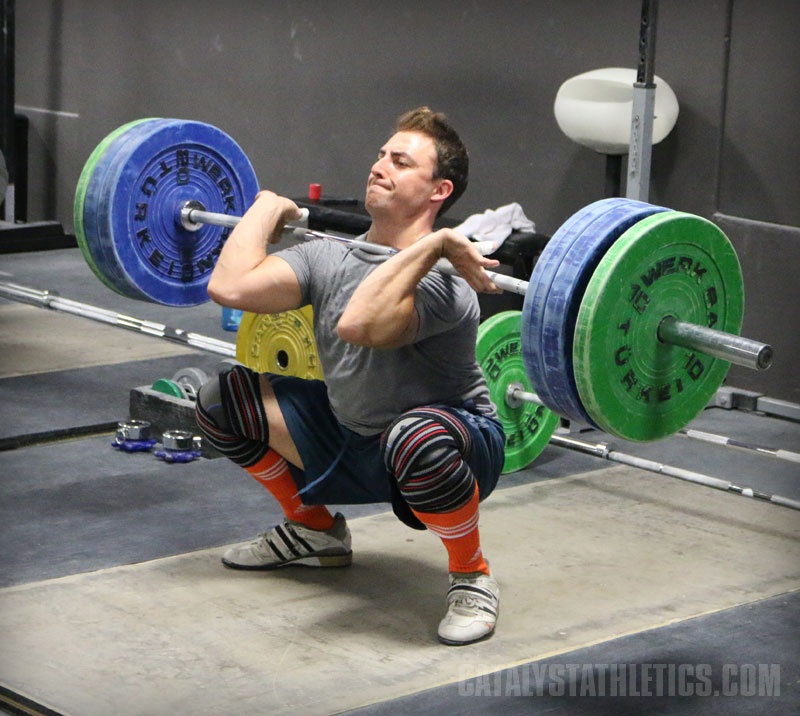Retaining Balance In The Lift When Increasing Weight
Retaining Balance In The Lift When Increasing Weight

Greg Everett is the coach of the Catalyst Athletics weightlifting team and author of the most popular book on weightlifting, Olympic Weightlifting: A Complete Guide for Athletes & Coaches. In this week's technique focus, Everett talks about the importance of focusing on balance in the first part of the lift, when working up to those heavy weights.

A common complaint is that a lifter’s weight feels too far forward in the snatch or clean, but only at heavier weights. Often the balance during the lift is forward at all weights and you simply aren’t aware of it when the weights are light because they’re not heavy enough to influence your position and balance further. That is, with 50% of your bodyweight, you can do just about anything and get away with it—an errant bar is easy to pull back to you later in the lift because your own bodyweight is enough to remain the anchor in the system. As the bar approaches your own weight, it has just as much control over you as you do over it. In this case, the errant bar pulls you out of position and you’re unable to simply muscle it back into place as needed later.

A common complaint is that a lifter’s weight feels too far forward in the snatch or clean, but only at heavier weights. Often the balance during the lift is forward at all weights and you simply aren’t aware of it when the weights are light because they’re not heavy enough to influence your position and balance further. That is, with 50% of your bodyweight, you can do just about anything and get away with it—an errant bar is easy to pull back to you later in the lift because your own bodyweight is enough to remain the anchor in the system. As the bar approaches your own weight, it has just as much control over you as you do over it. In this case, the errant bar pulls you out of position and you’re unable to simply muscle it back into place as needed later.
Another possibility (which could be occurring together with the previous) is that your mechanics are in fact changing as the weight increases. Most likely, this would be your hips moving up faster than your shoulders as you lift the bar from the floor. This is natural for most people, but in particular those with longer legs or who are posterior-chain dominate—both of these will mean that it will be hard for you to open your knee joint from a small angle because your quads are relatively weak and/or the lever arm is so long. The body will shift the work to whatever is strongest, and in such a case, it does this by opening the knee without opening the hip to create a larger knee angle without moving the weight very much. This then puts the knee at a larger angle that the quads can continue opening under the full load and transfers more of the weight to the stronger hip extensors. This can have two effects that will cause you a lot of trouble and certainly change the feel of the lift: shift your weight forward farther over your feet, and increase the moment arm on the hip. The first makes it impossible to finish your pull properly and forces you to chase the bar forward rather than being able to move it up and yourself down. The second makes the extension of the hips more difficult and consequently slower, making it tougher to get the quick explosion at the top of the pull that you need to have a chance to get under the bar.
Perform snatch and clean deadlifts and halting deadlifts with no more weight than what allows you to keep the proper upright posture. Focus on pushing with the legs to move the bar up to the thighs and shifting back to center your weight over the front edge of your heels and staying there all the way to the top. This will not only train you in terms of skill to pull correctly, but will begin to strengthen you in the proper posture. Remember that as the weight increases, your body will always revert to the positions in which it’s strongest. You can also combine halting deadlifts with snatches and cleans in a number of ways. The simplest is to perform 1-3 halting deadlifts followed by a snatch or clean. Another is to perform the halting deadlift and rather than returning to the floor, performing the snatch or clean straight from the paused position. This can work really well, but I will usually have a lifter follow a rep like this with a normal rep from the floor to help prevent them from developing a habit of pausing during a lift or hitching. Finally, more front squats for the clean and overhead squats for the snatch will strengthen the positions and boost your confidence.